 The original Benjamin A. Muncil boat house at Camp Topridge. Photos: MWanner, 22 October, 2007
The original Benjamin A. Muncil boat house at Camp Topridge. Photos: MWanner, 22 October, 2007 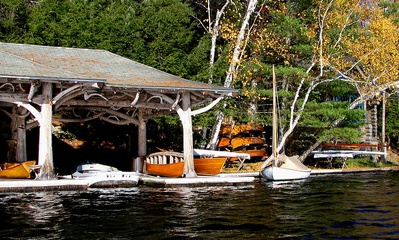 Closeup of the boat house at Camp Topridge
Closeup of the boat house at Camp Topridge 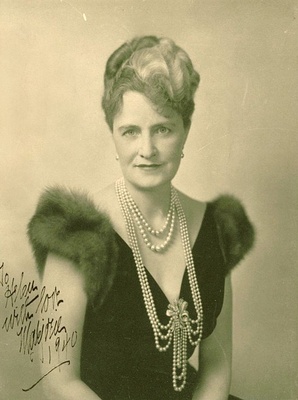 Marjorie Merriweather Post, a gift to Helen Garretson Trudeau, 1940. Courtesy of Ursula Trudeau via Mary Hotaling.
Marjorie Merriweather Post, a gift to Helen Garretson Trudeau, 1940. Courtesy of Ursula Trudeau via Mary Hotaling. 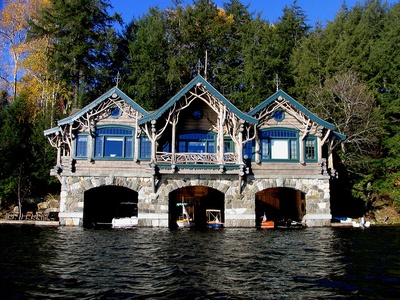 A newer boat house at Camp Topridge, built in 1999
A newer boat house at Camp Topridge, built in 1999 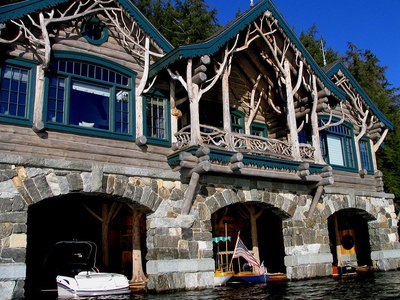 Closeup of the newer boat house Address: Upper St. Regis Lake
Closeup of the newer boat house Address: Upper St. Regis Lake
Other names: Camp Kanosa, Hutridge
Year built: Original Lothrop camp c. 1897; the camp has been extensively modified and expanded since 1920
Architect: Theodore Blake, Benjamin A. Muncil, others
Camp Topridge is an Adirondack Great Camp built over many years by several owners, especially after 1920 by Marjorie Merriweather Post, founder of General Foods and the daughter of C. W. Post.
The site was first purchased by Alvin M. Lothrop in 1897; he died in 1912, and Mrs. Post bought the property in 1920. She began extensive renovations to the camp soon after, especially involving the Main Lodge and the Boathouse. Several additional cabins were added to the camp and the property was expanded to 207 acres by the addition of one acre in 1924, 85 acres in 1938, and 118 acres in 1957. Building continued throughout the 1920s under the direction of local builder Ben Muncil.
Post changed the camp’s name to Camp Hutridge in honor of her second husband, financier E.F. Hutton, who she married in 1920.
In 1935, Post married her third husband, Joseph E. Davies, a Washington lawyer who, from 1936 to 1938, served as the second American ambassador to the Soviet Union, under Joseph Stalin. When they returned to the U.S., Post built a Russian Dacha at Topridege as an office for Davies. The camp’s name was changed to Camp Topridge at that time.
Post spoke of Topridge as a "rustic retreat"; it consisted of 68 buildings, including a fully staffed main lodge and private guest cabins, each staffed with its own butler. It was one of the largest of the Adirondack great camps and possibly the most elaborately furnished.
As originally built, the property could only be reached by water; guests arrived by float-plane or Post's yacht at a private dock, and thence via funicular to the main building at the top of the ridge. A driveway was added in later years. Three times a week, guests would gather in the 80 by 100-foot (30 m) living room where full-length movies could be screened; an adjoining dining room seated thirty guests. Many of the original furnishings of the room, which included an extensive collection of American Indian artifacts, are now in the Smithsonian Institution. Among the many elaborate structures on the property is a Russian dacha built for Post's third husband, Joseph E. Davies, who had served as ambassador to the Soviet Union.
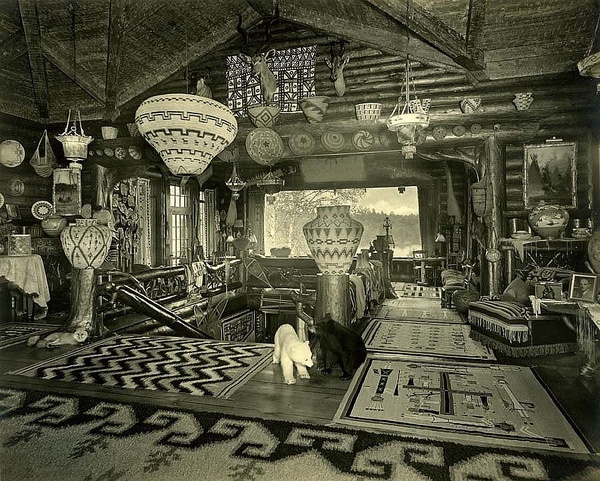 Staircase entry to the living room, 1959.
Staircase entry to the living room, 1959.
Courtesy of the Adirondack Experience; the museum has 72 photographs of Topridge
The estate was designed by local builder Benjamin A. Muncil in collaboration with New York architect Theodore Blake.
On her death in 1973, Post left the property to the State of New York, which added all but 105 acres to the Adirondack Forest Preserve, and used the main lodge and most of the buildings as a retreat for the Governor. In 1984, amidst growing complaints about the cost of maintaining the lavish compound, the state sold the property to Roger Jakubowski of New Jersey. Jakubowski went bankrupt, and real estate developer Harlan Crow of Texas acquired the property in 1994.
Under Crow's ownership, five buildings have been taken down and replaced by new structures, including the 1995 Honeymoon Cottage, the 1997 Bavarian Cottage, and the 1998 Russian cabin, a series of octagons topped by onion domes, reflecting Post's dacha. Four buildings have been extensively renovated, including an elaborate new entry for the main lodge.
James W. Riley, of Gabriels, worked there for many years.
The property is on the National Register of Historic Places (pdf) 1
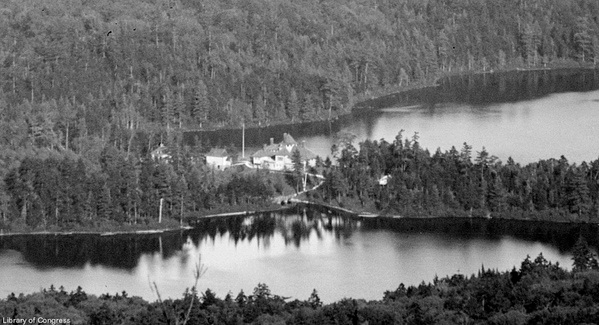 This compound predated Topridge on the esker. For the full photograph, of which this image is a detail, see the bottom of the page.
This compound predated Topridge on the esker. For the full photograph, of which this image is a detail, see the bottom of the page.
Sources:
- Kaiser, Harvey H., Great camps of the Adirondacks. Boston: David R. Godine, 1982. ISBN 0-87923-308-7.
 Guest beds at Topridge. Adirondack Daily Enterprise, April 23, 1988.
Guest beds at Topridge. Adirondack Daily Enterprise, April 23, 1988.  Russian tile stove in the Dacha. Adirondack Daily Enterprise, April 23, 1988 Adirondack Daily Enterprise, April 23, 1988
Russian tile stove in the Dacha. Adirondack Daily Enterprise, April 23, 1988 Adirondack Daily Enterprise, April 23, 1988
Grape-Nuts heiress held court at Topridge
Royalty slept here in sumptuous camp
"Some envy you your millions, some envy you your fame.
Some envy you the building great on which is carved your name;
Some envy you your luxuries and some your great success,
And some the force for doing things which you today possess."
The lines above composed by Edgar A. Guest, might well apply to Marjorie Merriweather Post, but they were written to honor her father, Charles William Post, the man who introduced "Postum" to the country in 1895.
Marjorie's father was born in Springfield, Ill., on Oct. 26, 1854. Thirty-seven years later he turned up at Battle Creek, Mich., and started a meteoric rise in the world of cereal.
Grape Nuts arrived in 1897 and was followed by Post Toasties in 1906.
C.W. Post was one of the self-made millionaires who reached national prominence around the turn of the century. He was gifted with an inventive mind and an astute perception of business methods.
Post married Ella Letitia Merriweather in Pawnee, Ill., on Nov. 4, 1874. On March 15,1887, Marjorie was born at Springfield. She was an only child. In 1888, the family moved to Fort Worth, Texas where the father tried his hand at several ventures, including land development. Two years later, Post's health failed and he went to Battle Creek to enter Dr. J.J. Kellogg's sanitarium, which had gained recognition as a vegetarian health center specializing in grain cereals. Coffee and tea were prohibited, as were all other stimulants. Served in their place were liquid substitutes brewed from parched grains.
Post, who was fond of coffee, found these concoctions unpalatable and was convinced that he could come up with something better. After many experiments he hit upon a mixture of roasted wheat berries, bran, and molasses which, with hot water, produced a nourishing drink. The product was named "Postum." The market results were phenomenal. By 1897, Postum's annual profit had reached $1.5 million. That was the beginning of a giant industry which, one day, would be dropped into the lap of his beautiful daughter.
Post trained Marjorie in the functions of his expanding business empire. She joined him on promotion trips in the U.S. and Europe. In 1902, they moved to Washington, D.C., where Marjorie was enrolled in an exclusive finishing school.
In 1904, the fond father-daughter relationship was strained when Post divorced Ella and married his secretary, Leila Young. One year later, Majorie married Edward Bennett Close. Post presented the newlyweds with a mansion in Greenwich, Conn. At the mansion, named the "Boulder," two daughters, Adelaide and Eleanor, were born to the couple. In 1914 while vacationing in Palm Beach with her husband, Marjorie received an even more tragic shock than her father's divorce. In a state of both physical and mental sickness, Post had shot himself. Marjorie and Ed immediately left for Battle Creek to attend the funeral.
When the U.S. entered WWI, Close enlisted in the army and. during his service, was awarded the French Medal of Honor. Due to the lengthy separation or, perhaps, to Marjorie's inheritance of a lucrative business plus $20 million in cash, the marriage soon floundered. After the separation was finalized. Marjorie moved to New York City where she met Ed Hutton, a wealthy and socially prominent Wall Street broker. The two young tycoons had much in common. They married in 1920 and spent their honeymoon on a round-the-world cruise. Hutton was an astute businessman and was soon involved in the operation of the Post Company. After three years, he was made Chairman of the Board. He acquired other well-known food products, such as Jell-O, Baker's Chocolate, Swan's Down Flour, Minute Tapioca, Maxwell House Coffee, Birdseye frozen foods and other, popular staples which were finally merged into the conglomerate known as General Foods.
On Dec. 29th. 1923 Nedenia Marjorie Hutton was born in New York City. She is known today as Dina Merrill, an actress and TV star.
During her previous marriage Marjorie had visited the Adirondacks with friends and liked what she saw. Returning with her current husband, the Huttons purchased Camp Topridge as a vacation place. Marjorie instigated a program of rebuilding. expansion, and decorating which brought the complex to forty buildings. A system of call buttons was installed. A touch of a finger would bring running a boatman, a masseur, a tennis partner, a fishing guide or a private secretary. Guests were assigned to individual cottages, each with its own fireplace, a fully-stocked bar, a bathroom for each bedroom and a telephone. All meals were served in the dining room at the main camp. The camp's living room was a veritable museum of wooden Indians, stuffed animals, Eskimo kayaks, assorted antlers entwined into light fixtures, mounted trophies from deep-sea fishing excursions, settees covered with animal hides, and a collection of numerous Indian artifacts, including some authentic scalps and a gruesome deck of playing cards made from human skin.
Topridge was Marjorie's showplace, where she entertained Washington politicians, military brass, big business moguls, international diplomats, and members of foreign royalty. General George C. Marshall, Prince Felix of Luxembourg and Mme. Nehru visited the camp.
Marjorie divorced Ed in 1935. Either before or after the break up, she had set her sights on Joseph Davies, a politician. Davies was already married. Rumors at the time suggested that the heiress bought off Mrs. Davies for $2 million. Davies was appointed U.S. Ambassador to Russia during F.D.R.'s second term. On their return, she built a Russian dacha at Topridge and decorated it with Moscow memorabilia.
The marriage to Joe Davies lasted twenty years, a record for Marjorie. In June of 1958, she married Herbert May of Pittsburgh, a successful businessman who was handsome and well-liked. Stories were circulated that, prior to the wedding, he had suffered some financial problems. If this was true, the matter was of no consequence after his marriage to the most wealthy woman in the U.S. May was more popular at Topridge than Davies. However, when Marjorie discovered that his congeniality masked a defect in her husband's character her final marriage collapsed.
Marjorie also maintained a lavish apartment in New York, her major residence, "Hillwood," in Washington and Mar-A-Lago in Palm Beach. Topridge was phenomenal and Mar-A-Lago was ostentatious.
She willed the estates to the public and, when she died in 1973, Topridge went to New York State. It was later peddled to a private owner.
Adirondack Daily Enterprise, August 20, 1964
Topridge Opened to Guests To Help Scholarship Fund
"When you talk about Adirondack camps," an old guide said," you always have to say what kind of camp. ... Mine's a one room shack back in the woods that's a camp. Some people build a platform and put up a tent. That's a camp. And some people can't live in the woods without they have a forty-room house... and that's a camp....".
This is a quotation from Adirondack Country by William Chapman White.
Tuesday a large group from this area had the opportunity to visit the third type of camp, Topridge, on Upper St. Regis Lake, owned by Mrs. Marjorie Merriweather Post. The tour was sponsored by the Women's College Club for the benefit of the club's scholarship fund One hundred people walked along beautifully graded path, rode the cable car from lake side to ridge and visited the numerous guest cottages.
Of particular interest was the Russian cottage which was imported in its entirety and rebuilt here by Russian architects. It contains many beautiful mementos of china, wood carving and tapestry and a decorated porcelain tile heater of the type formerly found in many elaborate European homes.
The famous Indian room in the main house contains an almost indescribable number of rare exhibits. These include countless mounted animals and birds of all kinds and the unusual use of animal skins and woven rugs to upholster the furniture. The group was impressed with the way in which, in part, nature designed the interior. Twisted knees and roots of wood were woven into patterns to form banisters and railings, light fixtures and radiator covers.
As the tour guests made their way through the grounds, they were met and assisted by many of the household staff who graciously and ably answered questions. The camp is over 40 years old and many additions and changes have taken place during this time.
Pictures were shown of the interiors when the camp is closed. Every piece of furniture is covered, every rug rolled up in mothballs and everything carefully marked for exact replacement. This operation takes six weeks each spring and fall.
[sic] boat landing and refreshments were provided for the guests by Mrs. Post. Arrangements for the tour were under the direction of Mrs. Irving Edelberg and Mrs. Richard Basile.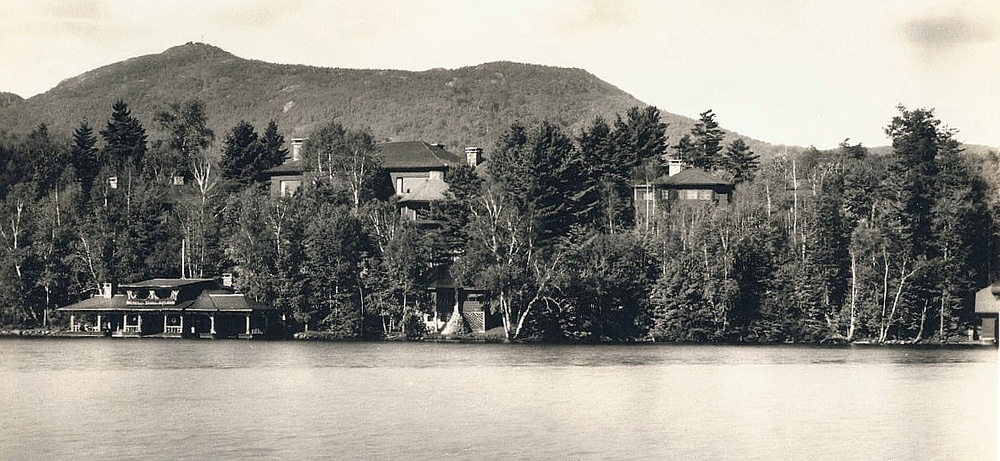 Camp Topridge and St. Regis Mountain, c. 1959
Camp Topridge and St. Regis Mountain, c. 1959
Courtesy of Adirondack Experience
 This shows the view from St. Regis Mountain, c. 1905. The compound that predated Topridge is in the center foreground. The two ponds at lower left, below the esker, are known as the Spectacle Ponds. The water above the esker is the northernmost arm of Upper St. Regis Lake; above that is Spitfire Lake. In the center left is Lower St. Regis Lake with Paul Smith's Hotel on the far shore. At the far left is Osgood Pond, and above the hotel is Jones Pond. For the rest of the view east of St. Regis Mountain, see the historic panorama on that page.
This shows the view from St. Regis Mountain, c. 1905. The compound that predated Topridge is in the center foreground. The two ponds at lower left, below the esker, are known as the Spectacle Ponds. The water above the esker is the northernmost arm of Upper St. Regis Lake; above that is Spitfire Lake. In the center left is Lower St. Regis Lake with Paul Smith's Hotel on the far shore. At the far left is Osgood Pond, and above the hotel is Jones Pond. For the rest of the view east of St. Regis Mountain, see the historic panorama on that page.
External links:
Comments
2010-02-12 15:38:23 Amanda Lester Ryan says: "My grandfather (Lawrence Lester) worked for Mrs. Post. He actually stayed on at Topridge as a caretaker afterward through several different owners. I have had some great times there throughout the years. Mrs. Post's cabin was always my favorite. Everything there was so girly, lots of pink. And a powder room most women would kill for, lol! It looks the same today as it did back then. The way she had the Main Lodge decorated was quite fascinating too. So much to look at." —amycatania
2010-02-12 15:39:33 Phill Greenland says, "I have a few older friends that worked for Ms. Post at Topridge. They've said many times what a lovely woman she was to work for. Very particular about everything staying super nice, but lovely and very kind." —amycatania
Footnotes
1. An earlier version of this article appeared originally on Wikipedia as Camp Topridge. Written by Mwanner and others: see its edit history at Wikipedia. It is licensed under the GDFL.



